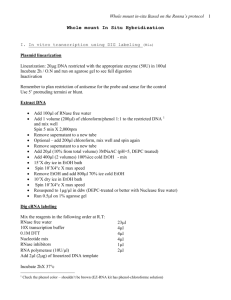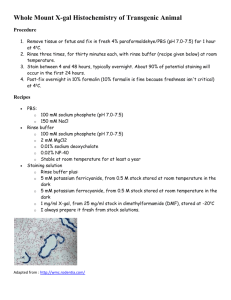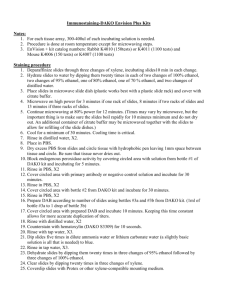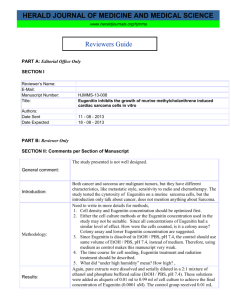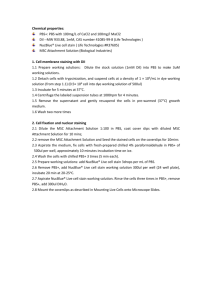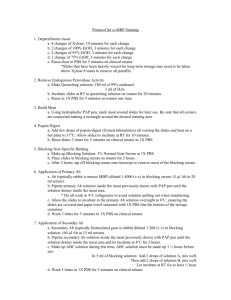Whole mount In Situ Hybridization
advertisement
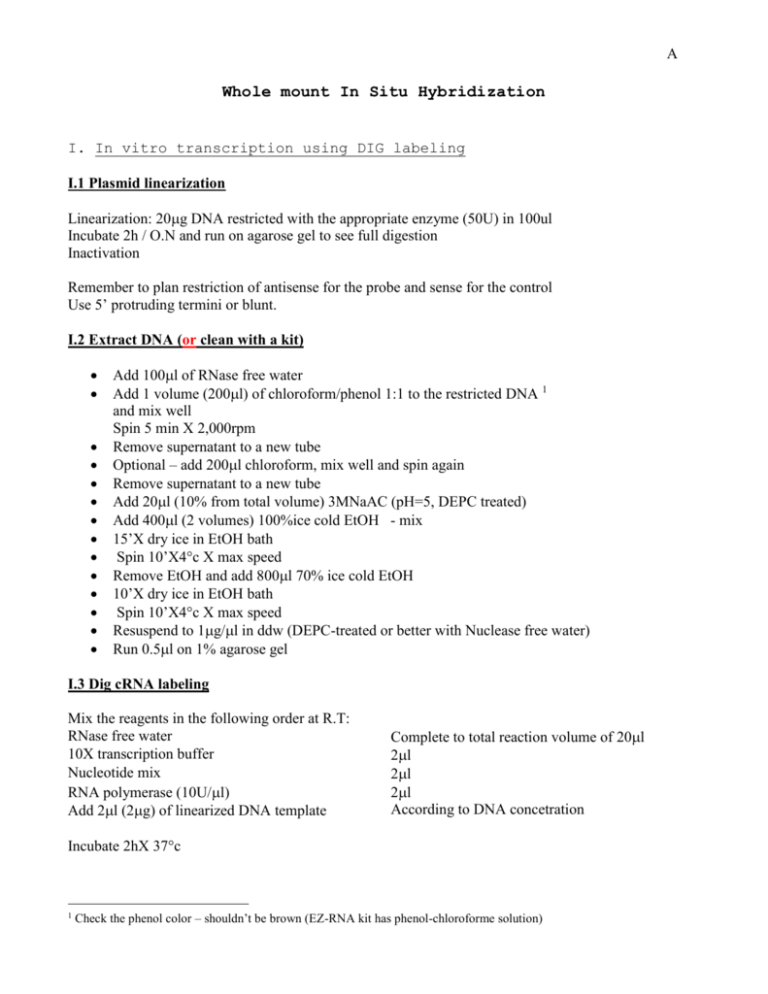
A
Whole mount In Situ Hybridization
I. In vitro transcription using DIG labeling
I.1 Plasmid linearization
Linearization: 20g DNA restricted with the appropriate enzyme (50U) in 100ul
Incubate 2h / O.N and run on agarose gel to see full digestion
Inactivation
Remember to plan restriction of antisense for the probe and sense for the control
Use 5’ protruding termini or blunt.
I.2 Extract DNA (or clean with a kit)
Add 100l of RNase free water
Add 1 volume (200l) of chloroform/phenol 1:1 to the restricted DNA 1
and mix well
Spin 5 min X 2,000rpm
Remove supernatant to a new tube
Optional – add 200l chloroform, mix well and spin again
Remove supernatant to a new tube
Add 20l (10% from total volume) 3MNaAC (pH=5, DEPC treated)
Add 400l (2 volumes) 100%ice cold EtOH - mix
15’X dry ice in EtOH bath
Spin 10’X4c X max speed
Remove EtOH and add 800l 70% ice cold EtOH
10’X dry ice in EtOH bath
Spin 10’X4c X max speed
Resuspend to 1g/l in ddw (DEPC-treated or better with Nuclease free water)
Run 0.5l on 1% agarose gel
I.3 Dig cRNA labeling
Mix the reagents in the following order at R.T:
RNase free water
10X transcription buffer
Nucleotide mix
RNA polymerase (10U/l)
Add 2l (2g) of linearized DNA template
Complete to total reaction volume of 20l
2l
2l
2l
According to DNA concetration
Incubate 2hX 37c
1
Check the phenol color – shouldn’t be brown (EZ-RNA kit has phenol-chloroforme solution)
A
I.4 DNase treatment
2l DNase I RNase free
Incubate 15-30’ X 37c
Inactivation 10’ X 65c
Take 1l for gel check (run on high voltage and photo after ~10 min). The RNA band should be ten fold
brighter than the DNA band.
OR, According To Dr. Tracy’s Wright Protocol :
I.3 Dig cRNA labeling
Mix the reagents in the following order at R.T:
RNase free water
10X transcription buffer
*DTT 0.1M
Nucleotide mix
RNA polymerase T3/T7(10U/l)
Add xl (1g) of linearized DNA template
Complete to total reaction volume of 20l
2l
2l
2l
1l
According to DNA concetration
Incubate 2hX 37c
* DTT 0.1M is found in RT-PCR box.
No need to add DNase I!
Clean (I.5 RNA purification) and then run on gel using RNase free running buffer + gel:
TAE 50X
DDW
EtBr
20 ml
980 ml
15 /l
Use the same solution the make the Gel.
I.5 RNA purification
Add RNase free water
- 180 l or
RNase free water 100l
add 10% volume 3M NaAC (in DEPC) - 20 l
4M LiCl
4l - mix
add 3 volume of ice cold 100% EtOH - 600 l
100%EtOH
300l
mix well & place in -20c X 30’ (or dry ice)
* Can precipitate O.N.
Centrifuge 13,000 rpm X 4c (or RT) X 15’. Remove supernatant.
Wash with 600l of 70% ice cold EtOH
Air dry for ~5 min & resuspend pellet with 30-100l RNase free water
Run 1l on 1% agarose gel (high voltage, ~ 10 min) and photocopy immediately
Store plasmid in -70c OR -20c.
A
II. Tissue Prep for ISH
A. Dissection
1. Dissect embryos in cold PBS (remove membrane as much as possible)
Use tools treated with RNase away and disposable bulbs
From E9.5 punctate 3 holes as described OR do it later, during ISH.
If the littermate is a mutant one: dissect each embryo separately (very convenient is to use 6 well
plate). Isolate the yolk sac and put it into a 1.5ml eppendorf tube. Put each embryo in a 1.5ml
eppendorf tube and mark it with the same number of it’s yolk sac. Embryos continue to fixation
and yolk sac should go short spin and DNA needs to be produced from them.
If the littermate is wild type: all the embryos can be fixed together in a 15ml tube. No need to
store tissue for DNA.
2. Fixation in 10ml/1ml fresh 4% paraformaldehyde at 4c X O.N X gentle rocking
B. Dehydration
24 hours after fixation (must be done the day after fixation).
Use 50 ml tube with 20 ml solution of:
PBT X 5’X 4c
-X2
25% methanol in PBT 5’X R.T
50% methanol in PBT 5’X R.T
75% methanol in PBT 5’X R.T
100% methanol
5’X R.T - X 2
Can store at -20c .
C. Rehydration (in the experiment day)
Use 50 ml tube with 50 ml solution of (diluted with in PBT):
75% methanol in PBT 5’X R.T
50% methanol in PBT 5’X R.T
25% methanol in PBT 5’X R.T
PBT X 5’X 4c
-X2
III. Pre-treatments/Deproteination
1. Treat with 10 µg/ml proteinase K in PTW for 10 min2
2. Wash 30 sec in 2 mg/ml glycine in PBT (fresh) X R.T
Wash 10’ in 2 mg/ml glycine in PBT (fresh) X R.T
3. Carefully rinse with PTW 2X 5 min
4. Incubate in Detergent Mix 2X 15 min, then rinse 2X 5 min PTW
5. Post-fix in 4% PFA (fresh - max 1 week old )+0.2% Glutraldehyde for 20 min
2
Our proteinase K is at a 15mg/ml concentration. Add 0.7µl to 1ml of PTW.
A
6. Rinse with PTW x 5 x shaker
OR, According To Dr. Tracy’s Wright Protocol :
III. Pre-treatments/Deproteination
1. Treat with 10 µg/ml proteinase K in PTW for 15 min. for day 10. day 8 – 10min.
2. Carefully rinse with PTW 2X 5 min.
3. Post-fix in 4% HCHO + 0.1% Glutraldehyde in PTW for 20 min.
4. Carefully rinse with PTW X 5 min. make holes in each embryo (see directions, only if not done
before). Transfer to 2ml tube.
IV. Hybridization
1. Rinse in 1:1 PTW to hybridization mix and let cochleae settle
2. Rinse in 1 ml hybrid mix and let cochleae settle
3. Incubate horizontally at 65ºC on shaker in 1ml fresh hyb mix for 1 hour
4. Add 1ml fresh pre-warmed hyb mix and 1µg (varies) DIG-labeled probe (if the probe is dissolved in
100µl DDW, add 5µl of probe)
5. Incubate horizontally at 65ºC on shaker overnight (O/N)
---------------------------------------------End of day #1-------------------------------------------------------V. Post-Hybridization Washes
1. Rinse 2X in pre-warmed hyb mix
2. Wash 2X 30 min at 65ºC with 1.5ml pre-warmed hyb mix
3. Wash 10 min at 65ºC with 1:1 hyb mix to MABT pre-warmed
4. Rinse 2X with 1.5ml MABT x 5’ x 65ºC (OR RT) – according to Tracy do RT
5. Incubate 1 hr with 1.5 ml MABT and 2% Boehringer Blocking Reagent (BBR).
6. Incubate 1 hour in 1 ml (exactly) of : MABT with 20% heat-treated sheep serum + 2% BBR ,
horizontally at 65ºC on shaker (OR RT). Get the tubes out of the oven and cool to room temp'.
7. Add 1/1000 (OR 1/2000) dilution AP-anti-DIG antibody. Incubate in 4°c X ON X rocking.
---------------------------------------------End of day #2-------------------------------------------------------VI. Post-Antibody Washes
1. Rinse 3X with MABT x 5’ x R.T x shaker
Transfer tissue into glass vials or 15ml tubes.
2. Wash 3X 1 hour with MABT at Room Temperature (RT) while shaking horizontally.
VII. Histochemistry
1. Wash 2X for 10 min in 5ml NTMT (fresh)
2. Incubate at RT in the dark while shaking with NTMT-BCIP-NBT mix
* purple color will develop (10 min- >3 days)
*change solution every few hours until color develops
A
3. Remove solution when color is developed
4. Wash for 10 min with 5ml NTMT (in this stage it is still reversible)
5. Wash for 10 min with PBS
*can be stored in PBS at 4ºC
VIII. Bleaching (Optional)
-Used to minimize background color
1. Warm cochleae to RT if originally at 4ºC
2. Replace PBS with 70% or 90% EtOH
3. Watch closely under microscope for background to start fading (about 3 min)
4. When desired color is reached, quickly remove EtOH and replace with PBS
X.Crayo sectioning
1. Fix with 4% PFA for 2 hours at RT OR ON at 4ºC
2. 5% sucrose in PBS (several hours - ON X RT).
3. 15% sucrose in PBS (several hours - ON X RT).
4. 7.5% gelatin in 15% sucrose/PBS (ON X 37ºC).[this solutions tends to contaminate quickly. If it is
not transparent, it could be contaminated and then make a fresh one. Contaminated solution will not
become solid].
5. Fresh 7.5% gelatin in 15% sucrose/PBS - embed in this solution.
Embedding means to let it become solid in RT or on a cold surface. Use microscope. If wrong
orientation was obtained, use microwave (10 seconds) to dissolve the solution (it does not harm the
embryos). Most important is the Embryo’s orientation. For Example if coronal sections are desired we
should embed it when it lays upside down (standing on it’s head), his back is leaned on the “wall” (1) of
the mold.
Important: the embedding solution should cover only the rectangle, not the whole mold. We will later
take the rectangle out and fix it to the cryostat when it sitting on the (1) wall, like a high building.
1
A
1. Set the cryostat on -30ºC in both chambers.
6. Freeze in liquid nitrogen only in the day of the section (Until that the embryos can be kept
embedded in Gelatin covered with Para film, in a moist chamber). Fill a bucket with liquid
nitrogen and dip the mold in it while holding it with tweezers, first only the ground of the mold
and once it is solid, dip quickly the whole mold inside. Put the mold in the cryostat. Do not forget
to write on it which embryo is it and mark the position of the embryo.
7. Remove block from mold and mount using a decent amount of OCT. before starting sectioning,
tune the block to be parallel to the knife and trim it so that the surface of sectioning will be
smaller.
8. Section at 14 µm. notes: use the handle to section. Play with the speed of your sectioning.
Tune the glass right, not too wide. Sections should come while one each one is connected to the
other as a chain. After about 9, collect them all together on a slide.
9. Degelatinize of the slides:
Rinse in cold PBS
Move to PBS x 37° for 1 min.
Return to cold PBS.
10. Mount slides using Flouromount-G [cat n. 0110-01, Lot; L0802-Z242, southern Biothecnology
Associates, USA].
Slides should not be dry when mounting, keep them in PBS while mounting the others.
Leave ON with weight on the slide.
The morning after: Clean with 70% Ethanol.
A
2.
Solutions and notes:
Illustration of regions in which holes should be made:
2
1
1-eye, 2-ear
4% Paraformaldehyde in PBS
It’s better to use fresh PFA up to 1 week is O.K
Remember to put all leftovers in organic waste
To make 250ml of 4% Paraformaldehyde
Wear disposable gloves throughout the procedure
1. Use a sterile 250ml Erlenmeyer flask.
2. Weigh out 10g of paraformaldehyde powder into flask.
3. Using disposable 50ml centrifuge tube, measure out 40ml of sterile water and put in flask.
4. Heat to 650c in an H2O bath.
5. Once solution has warmed to 650c, add 50µl of 10N NaOH, using a P200 tip.
6. Continue to swirl and heat solution in H2O bath.
7. Add 25ml of 10X PBS (Phosphate Buffer Saline), and 80µl of 6M HCl.
8. Bring solution up to 250ml with sterile H2O.
9. Check pH with litmus paper. Should range from 7.2 to 7.4.
10. Filter solution with 250ml filter bottle.
11. Label and place in cold room until ready to use.
PTW: 0.1% Tween-20 in PBS (1X)
Glutraldehyde: taken from Ruth Asheri. It is a 50% solution stored in 4°c.
A
Detergent Mix:
IGEPAL
500 µl
SDS
5 ml
deoxycholate
0.25 g
1 M Tris-HCl pH8
2.5 ml
500 mM EDTA pH8
100µl
5M NaCl
1.5 ml
DEPC H20
40.4 ml
-------------------------------------------------50.0 ml
Hybridization Mix: Formamide
25.00 ml
SSC (20x pH5 w/citric acid)3 3.25 ml
EDTA (0.5 M pH8)
0.50 ml
4
Yeast RNA (powder)
50 mg {final conc 1 mg/ml}
Tween-20 (10%)
1.00 ml
CHAPS (10%)
2.50 ml
Heparin (50 mg/ml)
0.10 ml {final conc 100 µg/ml}
Water
17.15 ml
----------------------------------------------------Total
50.00 ml
5X MABT:
Maleic Acid (50mM)
11.6 g
5
NaCl (0.74M )
8.7 g
Tween-20
11.0 ml
Water
185.0 ml
--------------------------------------------------Total
200.0 ml
Mix Maleic acid in ddw
Adjust pH to 7 using NaOH
Add NaCl (8.7g or 30 ml from 5M solution). To make MABT 1X dilute in DDW.
Maleic acid buffer:
100mM Maleic acid
250mM NaCl
adjust pH to 7.5 using conc. Or solid NaOH
3
250ml 20SSC pH7 + 50ml 1M citric acid. For a 1M citric acid solution – take 29.4gr in 100ml of nuclease free water.
Other protocols use baker yeast tRNA at a 1mg/ml final concentration.
5
Take 30ml of a 5M solution.
4
A
NTMT:
5M NaCl
2.0 ml
1M TrisHCl pH9.5
10.0 ml
2M MgCl2
2.5 ml
10% Tween-20
10.0 ml
Water
75.5 ml
-------------------------------------------------Total
100.0 ml
NTMT-BCIP-NBT Mix:
Use the ready solutions:
NTMT
10 ml
BCIP(50 mg/ml )
26.2 µl
NBT (100 mg/ml)
25.2 µl
OR, According To Dr. Tracy’s Wright Protocol :
More NBT/BCIP is used :
NTMT
BCIP(50 mg/ml )
NBT (100 mg/ml)
10 ml
30 µl
31 µl
[based on 17µl/1ml NTMT of the NBT/BCIP stock solution, 18.75 mg/ml NBT + 9.4 mg/ml BCIP]
Sheep serum (CHEMICON S22-100mL)
Inactivate 56c X 30’
Cool on ice
Centrifuge and dived the sup to 1 ml aliquots (important in order to lose the protein precipitate)
BBR (Rochecat. No. 1 096 176)
Prepare X10 stock solution
Dissolve blocking reagent in Maleic acid buffer to final concentration of 10% (w/v)
Mix and heat to 60c X 1h (do not boil) and make sure reagent is completely dissolved
Store in aliquots of 1.5 ml in –15 to -25c
Dilute the X10 solution with Maleic acid buffer to a X1 blocking solution on the experiment day.
Always prepare fresh
OR, According To Dr. Tracy’s Wright Protocol :
BBR (Blocking Reagent, 1 096 176, Roche) prepare 2% solution by weight. 1gr in 50ml MABT 1X,
heat to 650c (dissolving takes time), can be store at -200c later.
A
Heparin ( H 3393, Soduim Salt, Grade 1-A from porcine intestinal mucosa, Sigma)
Y.RNA (R 6625, Toricle, Sigma).
Sheep Serum (Lot 42K8412 S-2263, sterile filtered, Sigma)
